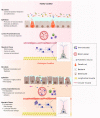Hyaluronan: A Neuroimmune Modulator in the Microbiota-Gut Axis
- PMID: 35011688
- PMCID: PMC8750446
- DOI: 10.3390/cells11010126
Hyaluronan: A Neuroimmune Modulator in the Microbiota-Gut Axis
Abstract
The commensal microbiota plays a fundamental role in maintaining host gut homeostasis by controlling several metabolic, neuronal and immune functions. Conversely, changes in the gut microenvironment may alter the saprophytic microbial community and function, hampering the positive relationship with the host. In this bidirectional interplay between the gut microbiota and the host, hyaluronan (HA), an unbranched glycosaminoglycan component of the extracellular matrix, has a multifaceted role. HA is fundamental for bacterial metabolism and influences bacterial adhesiveness to the mucosal layer and diffusion across the epithelial barrier. In the host, HA may be produced and distributed in different cellular components within the gut microenvironment, playing a role in the modulation of immune and neuronal responses. This review covers the more recent studies highlighting the relevance of HA as a putative modulator of the communication between luminal bacteria and the host gut neuro-immune axis both in health and disease conditions, such as inflammatory bowel disease and ischemia/reperfusion injury.
Keywords: enteric nervous system; gastrointestinal tract; gut microbiota; hyaluronan; immune system.
Conflict of interest statement
The authors declare no conflict of interest.
Figures


References
-
- Manou D., Caon I., Bouris P., Triantaphyllidou I.E., Giaroni C., Passi A., Karamanos N.K., Vigetti D., Theocharis A.D. Methods in Molecular Biology. Volume 1952. Humana Press Inc.; New York, NY, USA: 2019. The complex interplay between extracellular matrix and cells in tissues; pp. 1–20. - PubMed
Publication types
MeSH terms
Substances
LinkOut - more resources
Full Text Sources

